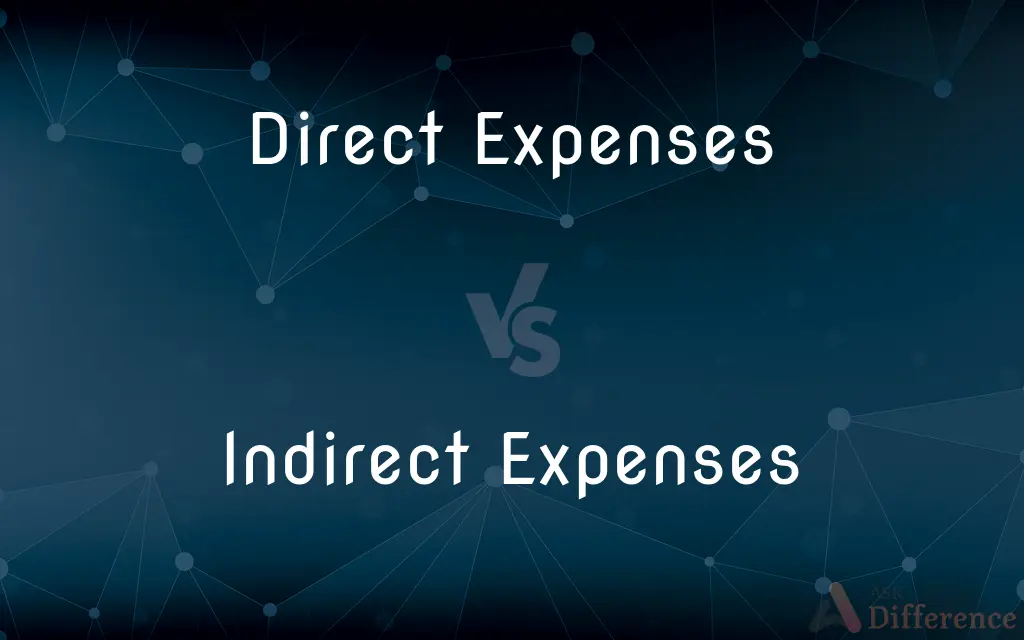Direct Expenses vs. Indirect Expenses — What's the Difference?
By Tayyaba Rehman — Published on November 6, 2023
Direct Expenses are costs directly tied to a specific product or service, while Indirect Expenses are general costs not linked to any specific item or service.

Difference Between Direct Expenses and Indirect Expenses
Table of Contents
ADVERTISEMENT
Key Differences
Direct Expenses can be attributed directly to a specific product, service, or project. For instance, if a company is manufacturing a product, the raw materials used for that particular product are considered Direct Expenses. On the other hand, Indirect Expenses are those costs that cannot be directly associated with a particular product or service. They're necessary for business operations but aren't directly tied to a single revenue-generating activity.
In accounting and financial reporting, distinguishing between Direct Expenses and Indirect Expenses is essential. Direct Expenses are directly allocated to cost objects like products, whereas Indirect Expenses are allocated to multiple cost objects or across departments. This distinction ensures that profit margins are correctly calculated for individual products or services.
For a clearer perspective, consider the example of a shoe manufacturing company. The leather used in making a specific shoe model would be a Direct Expense. In contrast, the electricity bill for the factory, which supports the entire production process, would be an Indirect Expense. Both types of expenses impact the final cost of a product, but they are accounted for differently.
Ultimately, the categorization of expenses as Direct Expenses or Indirect Expenses aids in pricing strategies, profitability analysis, and budgeting decisions. While both are essential for business operations, recognizing their differences can provide better financial insight and management.
Comparison Chart
Association
Specific product, service, or project
General business operations
ADVERTISEMENT
Allocation
Directly to cost objects
Spread across multiple cost objects or departments
Examples
Raw materials, direct labor
Rent, utilities, office supplies
Impact on Profit Margin Calculation
Directly affects the profit margin of specific items
Affects the overall profitability of the business
Pricing Strategy Relevance
Essential for setting prices for specific items
Considered when determining overall pricing strategies
Compare with Definitions
Direct Expenses
Direct Expenses can be traced to specific cost objects.
The cost of the paint used for a specific artwork is a Direct Expense.
Indirect Expenses
Indirect Expenses support the overall business operations.
The monthly rent of the office is an Indirect Expense.
Direct Expenses
They can be directly allocated to products or services.
The wages of workers on a specific project are Direct Expenses for that project.
Indirect Expenses
They impact the business's overall profitability.
Increasing Indirect Expenses affected the company's net profit margin.
Direct Expenses
Direct Expenses vary based on the volume of output.
The more units produced, the higher the Direct Expenses.
Indirect Expenses
Indirect Expenses are distributed across multiple cost objects.
The cost of maintenance is an Indirect Expense spread across various departments.
Direct Expenses
They are essential for calculating the profitability of specific items.
Considering Direct Expenses helped determine the selling price of the gadget.
Indirect Expenses
They can't be traced back to a specific product or service.
The company's advertising budget is an Indirect Expense.
Direct Expenses
Direct Expenses are costs directly attributed to specific outputs.
The cost of the fabric is a Direct Expense for the shirt manufacturing.
Indirect Expenses
Indirect Expenses remain fairly constant regardless of output volume.
Whether producing 100 or 1,000 units, the utility bill remains an Indirect Expense.
Common Curiosities
Why is it essential to differentiate between the two types of expenses?
Differentiating helps in accurate profitability calculations, pricing strategies, and budgeting decisions.
What are Direct Expenses?
Direct Expenses are costs directly associated with a specific product, service, or project.
Can Direct Expenses impact pricing decisions?
Yes, Direct Expenses play a crucial role in setting prices for specific products or services.
Are utility bills considered Direct or Indirect Expenses?
Utility bills are typically considered Indirect Expenses as they support general business operations.
Does a business have more Direct or Indirect Expenses?
It varies by business. Manufacturing businesses might have more Direct Expenses, while service businesses might have more Indirect Expenses.
How do Indirect Expenses differ from Direct Expenses?
Indirect Expenses are general costs that support overall business operations and can't be traced to a specific item or service.
How are Indirect Expenses allocated in financial reporting?
Indirect Expenses are allocated across multiple cost objects or departments, often using a predetermined rate.
Can Indirect Expenses vary with production volume?
Generally, Indirect Expenses remain fairly constant, regardless of the production volume.
What is an example of a Direct Expense in a restaurant?
The cost of ingredients for a specific dish is a Direct Expense in a restaurant.
Are employee salaries Direct Expenses?
Salaries can be Direct Expenses if tied to specific projects or products, but general administrative salaries are Indirect Expenses.
Why are Indirect Expenses sometimes called overhead costs?
Because they're general costs that don't directly contribute to a product or service but are necessary for business operations.
How do Direct Expenses impact profit margins?
Direct Expenses directly affect the profit margin of specific items, as they determine the cost of producing that item.
Share Your Discovery

Previous Comparison
Molecular Equation vs. Ionic Equation
Next Comparison
Magnesium Glycinate vs. Magnesium GluconateAuthor Spotlight
Written by
Tayyaba RehmanTayyaba Rehman is a distinguished writer, currently serving as a primary contributor to askdifference.com. As a researcher in semantics and etymology, Tayyaba's passion for the complexity of languages and their distinctions has found a perfect home on the platform. Tayyaba delves into the intricacies of language, distinguishing between commonly confused words and phrases, thereby providing clarity for readers worldwide.












































